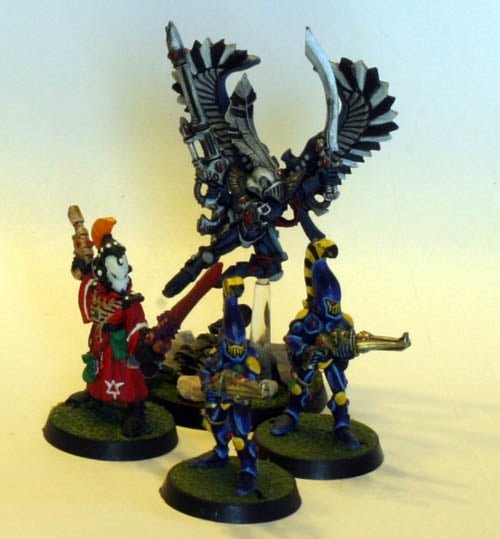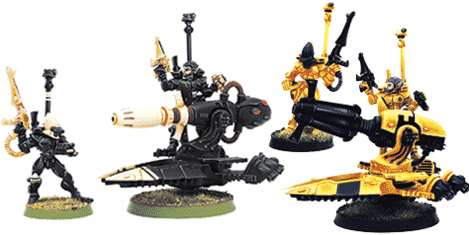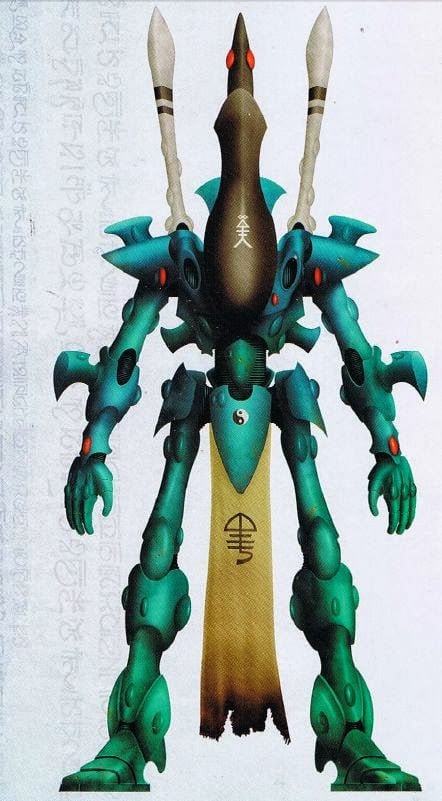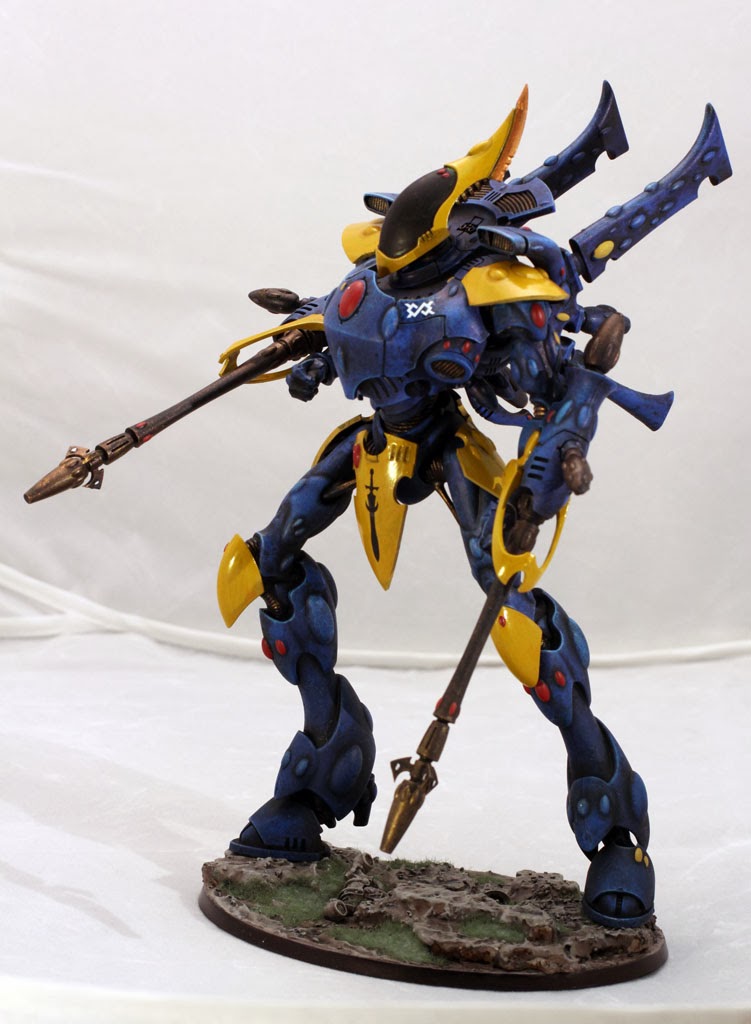40K TACTICS: Eldar Heavy Support – Infantry

Hey guys, I am Learn2Eel I’m here to continue our series on Codex: Eldar. The Craftworlders are back with a vengeance.
Eldar – Heavy Support – Infantry
Do you ever feel like halting the charade of arguing and just doing the deed then and there? Do you feel like an engagement simply needs a big gun in order to sway favourably? Do you want to know what the combination of evisceration, laceration, immolation and disintegration results in? Do you ever want to kill someone so hard that they die to death? Well hey, get yourself a new Tau army and let us know how it goes! Jokes aside, the Eldar bring some serious firepower in the Heavy Support section, with each unit typically specialising in destroying a particular kind of enemy. Dark Reapers excel at hunting power-armoured foes such as Space Marines, and jump – or just sit there, speechless and grim – with glee every time they such forces as their quarry. Support Batteries and Falcons are more based upon what you need, as they provide a mix or can be upgraded to suit different roles. The Wraithknight and Wraithlord have similar adaptability, but as tough monsters that can also smash through near anything in a melee. War Walkers are mobile and deadly, usually against vehicles as the codex does lack such quantitative long or medium range anti-tank elsewhere. The Fire Prism is the most versatile of any choice, with multiple fire modes geared to engaging any foe with high success. It helps that all of these units are amongst the most durable in the codex for their type, and with Battle Focus and typical long ranges thrown in, you can afford to sit back or slowly advance at a steady pace. Keeping these precious units alive is as much an investment as the units themselves.
A note here that I will be covering the non-vehicular units exclusively in this article, for the rest of the Heavy Support section, see part one of my review.
Dark Reapers – Embracing the aspect of war more fully than any other shrine, the Dark Reapers are Khaine’s wrath embodied; graceful killers without mercy, they will slaughter all manner of foe if left unchecked. As the most expensive of the aspects – if you exclude the Crimson Hunter – per model, Dark Reapers pay rather heavily for strong firepower at extreme ranges, though they also sacrifice some handy rules to do so. They lack both Battle Focus and Fleet, with Slow and Purposeful instead thrown in to allow them to fire their heavy weapons on the move; unfortunately, this disbars them from running or Overwatching, limiting their defensive roles. Because they can’t really defend themselves from a charge or quickly escape encroaching enemies without the use of a transport, Dark Reapers should be supported by nearby counter-assault units – such as Howling Banshees – to protect them from fast moving melee units such as Assault Marines. Otherwise, Dark Reapers are fairly typical of Aspect Warriors; a Ballistic Skill of four and a 3+ armour save in particular are very handy both for maximising their damage output at range and, even with a Toughness of three, being able to withstand decent firepower in return. Where it counts though, Dark Reapers do deliver; each carries a Reaper Launcher – similar to an Eldar Missile Launcher – stock with starswarm missiles. These fire a volley of two Strength five AP three shots, decimating medium and light infantry alike; they also find some use against light vehicles. That they ignore Jink saves owing to their Reaper Rangefinders is sure to be harrowing for the lightly armoured skimmers employed by Dark Eldar in particular. For a rather costly increase, the Reapers can take starshot missiles which act as a regular Strength eight AP three anti-tank shell, though one must ask whether anti-tank firepower is better served elsewhere owing to the cost. Each missile variant has a long range of forty eight inches, and though neither ignore cover saves – except those provided by Jink – they are rightly devastating against their preferred enemies, from power-armoured foes to medium tanks.
The unit has a maximum squad size of ten, which is very handy for larger games but hardly cost-effective in normal battles; the high points costs of each model, particularly when given the starshot missiles to deal with vehicles, make for a horrendously expensive unit. With a Toughness of three and 3+ armour save, as well as near mandatory support from friendly units, I do not feel Reapers will be worth it in larger units; such forces will simply be overkill anyway. In that sense, if you wish to use them I would take either one or more squads of about five or so, striking a happy medium between cost and damage output. Additional options include an Exarch who has access to a wide range of weapons, though one in particular shines if the Reapers are used for slaughtering power-armoured foes. The Ballistic Skill of five is handy, but the lack of a Leadership boost means that the Exarch isn’t really necessary unless you take one of those special weapons. Oddly, the Exarch can exchange their reaper launcher for a shuriken cannon; unless you want some potential armour-ignoring wounds against Terminator-equivalents or light anti-tank suppression, I personally wouldn’t bother with it. The rest of the codex deals quite well with such units anyway, with even the basic troops and transports more than capable of fulfilling those roles.
The Exarch can take a proper missile launcher, though this should mostly be either for Pinning shots or to give them an anti-tank weapon as, strangely, they lack the option to take starshot missiles like regular Reapers. Flakk missiles are available at an additional cost, but one mediocre skyfire units for a high price in a dedicated ground-support unit simply isn’t viable. The most expensive but potentially devastating option is the Tempest Launcher; firing two small blasts with the barrage rules at a range of thirty-six inches, this Strength four and AP three weapon is very nasty indeed against medium infantry but little else. Combined with an Exarch power such as Fast Shot, this can make even a small Reaper squad annihilate near any Space Marine squad with impunity. Handily, Reapers can also employ a Wave Serpent for transport purposes but, owing to their superior range, they do not really require it if set up in a good position and supported well. Due to the sheer effectiveness of the Wave Serpent as a battle tank, this can be a good way to effectively add in two ‘heavy support’ choices while only using up one slot. All in all, I find Dark Reapers are perhaps a tad too expensive for what they bring; they are flimsy despite the 3+ armour save. Additionally, with little mobility and mostly dedicated anti-infantry firepower, I am not sure they can match the cost-effectiveness and utility of a Wave Serpent to your army.
Vaul’s Wrath Support Battery – As one of the few sources for true artillery in the codex, the Support Batteries have a defined role in a mixed Eldar army; providing long range firepower against specific types of targets dependent on what you require. Each gun out of a potential three in a unit has two Guardian crew, meaning that they are – predictably – quite frail in combat and under sustained fire. As Artillery, they use the Toughness of seven provided by the gun save for in a melee which means enemies will typically require anti-tank weaponry to destroy them reliably. That the gun itself has two wounds and a 3+ armour save makes it difficult to deal with by small arms fire, and it can be used at the front to soak up a wound with the new wound allocation rules. Of course, that isn’t why you employ artillery; each of the three weapon options provides some nasty firepower at mostly long ranges, with one exception. The base weapon included with the battery is the shadow weaver, firing a barrage small blast with a Strength and AP of six. Though this doesn’t seem too impressive save for doing light but unreliable damage against lesser vehicles or barrage sniping out special weapon gunners or characters, the Shadow Weaver also has the monofilament special rule. That each wound caused can potentially be AP one on a to wound roll of a six gives it some nasty bite against more heavily armoured units, and the bonus to Strength against units with a low or completely lacking Initiative value makes it very viable against vehicles of most kinds.
If it isn’t to your fancy, you can make a free exchange to the Vibro Cannon, and be aware that each Support Battery in a unit must have the same gun. The Vibro Cannons are effectively missile launchers with a twist; their Strength of seven and AP four with a single shot isn’t that impressive, but the Vibro special rule means that any hit after the first increases the Strength and reduces the AP of each hit in the unit by one. In a unit of three support batteries with a Ballistic Skill of four, they average two hits, increasing the Strength to eight and the AP to three, becoming pseudo missile launchers. When paired with re-rolls to hit or a bit of luck, they will inflict three hits at a Strength of nine and AP two, simply mimicking lascannon fire. Given that it is a free upgrade, and their reliability, they compare far more favourably to Dark Reapers armed with starshot missiles; three Reapers with those upgrades are more expensive than a trio of Support Batteries, and have four less Toughness and one less wound to spread around. Their only advantages come in the form of ignoring Jink saves as well as the alternate starswarm missiles, though I would argue the potential for ‘lascannon’ hits outweighs these for cheap heavy anti-vehicle duties.
The third and final weapon option is the D-Cannon, and you pay a hefty price for it; you can almost purchase another Support Battery for the cost of upgrading just one to have this admittedly devastating weapon. With a Strength of ten and AP of two, this small blast weapon is only restricted by its mediocre range and unreliability inherent with being a scatter-based gun. The twenty-four inch range means that either the early turns have to be spent moving up into a good firing position, or they have to be deployed smartly so as to punish any foes that attempt to move into your back-field or the midfield. The Distort rule allows these to inflict instant death on any enemy, such as monstrous creatures, which can be a harrowing possibility that even the mere potential of it can frighten enemies into avoiding them. They are the strongest at destroying vehicles or tearing apart infantry provided they roll well to hit, though they pay dearly for it. I can’t really recommend a gun above any other; the D-Cannon seems just a bit too expensive, but is undeniably brutal, while the other two do particularly well either against infantry or vehicles and monsters alike. I recommend taking units of three as two or one may be a bit too easy for your opponent to remove. They are a good and cheap source of heavy firepower that you should really consider.
Wraithlord – A medium sized wraith construct that trades a high number of wounds for a ridiculous Toughness value, the Wraithlord is a resilient and versatile monstrous creature that offers strong firepower and nasty melee capabilities. Before I delve into the damage one is capable of, their durability needs to be mentioned; with a Toughness of eight, three wounds and a 3+ armour save, Wraithlords laugh off almost any kind of small arms fire. The common bolter cannot even harm a Wraithlord, and high strength weapons such as missile launchers and plasma guns need fives and fours to wound it, a true change of pace that many won’t be expecting. Though three wounds is very low for a monstrous creature, the high Toughness is the trade off that you pay for; helpfully, Wraithlords are quite cheap for what they bring. The new cover rules in 6th Edition heavily favour monstrous creatures, meaning that even a tiny part of the Wraithlord’s base can be in cover and it will benefit from – usually – at least a 5+ cover save. This makes up for its notable lack of an invulnerable save, and serves to give it some added protection against the missile launchers and lascannons that actually are a reliable threat against it.
The Wraithlord has a strong overall stat line; a Weapon Skill, Ballistic Skill and Initiative of four typical of most wraith constructs is very solid for a monster, though the Strength of eight is surely the most impressive. This, in conjunction with three base attacks, allow the Wraithlord to quite effectively deal with low rear-armour vehicles vehicles without Smashing and inflict instant death on the majority of commanders in the game. Handily, the Wraithlord is also a character, allowing it to challenge enemy independent and regular characters and beat them to death with its nasty instant death potential and balanced stats. Singling out characters with power fists and the like is very useful, particularly against Orks and the like who usually would have no other means of taking down a Wraithlord in combat. Did I mention Hammer of Wrath at Strength eight, potentially killing a model outright at Initiative ten? Though a Wraithlord can easily be tar-pitted due to its lack of strong Weapon Skill and high attacks, it nonetheless should do very well against most targets and itself serve as a hold-up unit if the need is there. As a Fearless monster, this is actually a good use of the Wraithlord, though bear in mind that its extensive array of ranged weaponry are probably best served out of protracted combats. One of the useful options for a Wraithlord that is always advised if you have points spare and want the model to look awesome is the ghost-glaive; for a minimal cost and at no other expense in terms of weaponry, you gain a re-roll to hit in combat and a bonus of one to the Wraithlords’ Strength. Striking at Strength nine before Smashing and gaining a re-roll to hit is worth the minimal price every time, and really helps if you need to maximise your damage output in combat. Against enemy characters that could potentially harm a Wraithlord, this is key and the boost of Strength helps when not Smashing against vehicles or other wraith monsters.
What gives the Wraithlord a lot of utility in a mixed Eldar army list is the firepower it offers; though it is always useful as a fire magnet and for combat purposes, the Wraithlord brings up to two heavy weapons and some nasty short range anti-infantry shooting. It comes stock with two wrist-mounted shuriken catapults, providing decent damage at short ranges with the potential for automatic wounds at AP two. However, the far more popular and competitive choice is to exchange them for a pair of flamers at no cost; not only does the similarly short range play into the flamers’ favour, but the sheer number of automatic hits they provide that ignore cover is ludicrous against any kind of infantry. For a monstrous creature that typically lacks the means to deal with large numbers of infantry, such as Hormagaunts, this is a vital choice and, with the defensive boost provided by Overwatch, it also dissuades chargers for what is already a tough melee unit. Though the Wraithlord is restricted to firing only two weapons a turn, it is nonetheless a good option to take one or two of the various heavy weapons on offer; the reason for this is to keep it effective against a wide range of targets. The flamers deal with any infantry units that get close, while your harder-hitting guns devastate tanks or heavy infantry at long ranges.
The Wraithlord has five different weapons to choose from, and each can be mixed and matched in any order you see fit; I would however discourage mixing of two separate weapons for the most part owing to differing ranges and roles. The cheapest by a small margin is the Shuriken Cannon, which provides decent all-rounder shooting at medium range. The three ‘middle’ options are identical in cost but separate in role; the bright lance is dedicated to tank hunting, the scatter laser is yet another all rounder and the starcannon is geared for hunting heavy infantry. The most expensive option by a rather large margin is the Eldar Missile Launcher with both plasma and starshot missiles – or frag and krak, in Imperial terms – that seemingly pays unfairly for Pinning and an AP of four on the plasma rounds. I would say that there is no best option here, though the Scatter Laser is the one weapon that you should always use in a mixed pairing owing to its Laser Lock special rule to twin-link the other gun. Take what you feel is lacking in your army list; for anti-tank and busting Land Raiders, a pair of bright lances will serve you best, for example. However, I would clarify that as even basic Eldar infantry deal with elite infantry incredibly well, the Starcannons aren’t as necessary as the bright lances or scatter lasers would be due to their higher effectiveness against vehicles. However, Starcannons do excel against most monstrous creatures, so deciding which weapons to use – if any – are key to employing a Wraithlord that works in your army list. To employ this cost effective monster, I would certainly keep it diversified with long-range anti-tank and short-range anti-infantry firepower as my preferred build. In a mixed army where the slow speed of the Wraithlord isn’t as jarring, having it slowly move up from cover to cover if need be to provide both fire support and counter-charge support for your infantry is key. A Dire Avenger unit alone won’t hold out long against a strong charge, but backed by a Wraithlord with a ghost-glaive, the battle will likely swing in their favour. Remember to use the Wraithlord not as a line-breaker or ‘death-star’ much like a Trygon or flying Daemon Prince, but as a support unit that, while tough, is best used in conjunction with the rest of the army to provide firepower that you lack and melee potential that you need. A great unit that shares two great assets; a low cost, and incredible versatility.
Wraithknight – As the largest Warhammer 40000 model ever released for use in standard games, the Wraithknight has a rather large pedigree to live up to. With expectations ripe after the amazing success of the Riptide, the self-coined ‘little fishy’ counter-part to the wraith construct, it goes without saying that the Wraithknight is – or will prove to be – a very popular unit. Given that its miniature cousin the Wraithlord shares the same slot, it is noteworthy to point out some of the key differences; notably that the Wraithknight has double the wounds and lacks the status of a character. While this does limit its ability to leap into an enemy unit, single out a bothersome character with a power fist or simply because they are a Warlord and kill them with little difficulty, the Wraithknight does have effectively double the durability. In fact, it is quite possibly the hardiest monstrous creature in the game; with a Toughness of eight meaning Strength four and lower weaponry cannot even harm it, as well as a ridiculous six wounds with a 3+ armour save, it laughs off almost any form of heavy or regular weaponry. The only viable method of dealing with such a model reliably is either through instant death or massed poison weaponry, as the high availability of cover saves for a Wraithknight allow it to ignore most heavy weapons quite easily. That it has six wounds and, laughably, gains cover from standing in terrain despite its gargantuan height is sure to be a pet peeve for anyone foolish enough to waste shots at it. For this reason alone is the Wraithknight used in competitive armies, as it is simply a fire magnet without peer; it can soak up wounds from nearly anything and, statistically, most armies – particularly due to the movement more to Strength seven – will waste multiple turns of their entire army firing to defeat it. That it moves so quickly and strikes so hard in both the shooting and assault phases is the candy that your opponent simply won’t want to resist; tricking them into firing at a Wraithknight frees up the rest of your army in a big way.
What makes the Wraithknight so difficult to ignore is its sheer speed; as a jump monstrous creature, it moves up to twelve inches in the movement phase. With Move Through Cover, it ignores dangerous terrain and thus can jump from cover to cover and benefit from saves against armour-ignoring weaponry while not being slowed at all. Considering most armies lack both poison and instant death in abundance, the common method of dealing with the Wraithknight, that being heavy weapons, will likely leave most opponents tearing their hair out in frustration at their puny attempts to kill the giant. Between Fearless and this great mobility, the Wraithknight can be used as a hammer that forces your opponent to fire at it; jump towards a Land Raider or squad with a valuable Warlord in it, and watch as the unit others claim can be ignored is the focus of extensive enemy attention. That its stock ranged guns have a long range and can potentially inflict instant death on a costly monster or annihilate an expensive transport with a frighteningly good chance of success is yet another cog in the mind games key to using a line-breaker. When using the Wraithknight in this way – and you really always should – be sure to identify which units would be the most threatening or viable as targets; the range of its guns allow it to stay away from most poisoned weapons, though taking on lone squads or unsupported vehicles and monsters is a smart tactic. It is a battering ram splattered with the blood of opposing nobility, garishly moving in stride with its fellow soldiers and brandishing its superiority.
As a combat unit, the Wraithknight is very decent indeed; the Toughness of eight allows it to ignore most enemies outright, and it has the speed to both put early pressure on opponents and more reliably choose its engagements. Where it really starts to shine is in its offensive potential; it strikes with four attacks at Strength ten and Initiative five, all the better to stomp enemy units into dust. Few things short of a properly equipped Dreadknight or Daemon Prince can reliably beat it in a melee owing to its sheer Toughness, Fearless and number of wounds. That it will inflict instant death on nearly any enemy it gets into combat with and, handily, tear apart any vehicle stupid enough to get within eighteen inches of it is yet another tick against one of the more fearsome monsters of 6th Edition. Though it isn’t a character and thus cannot single out enemy characters, this can work to your advantage as it means you can’t be held up by annoying enemies for more than two player turns. Add in Fear and Hammer of Wrath at Strength ten, and you have a veritable wrecking ball against almost any kind of enemy.
The Wraithknight has multiple configurations that really diversify its role, but for the most part, I would simply recommend sticking with the stock weapon load out. There are three major options you can take, with up to two extra heavy guns on the side. The first is a pair of heavy wraithcannons which each fire a single shot at thirty six inches with a Strength of ten, an AP of two and the Distort special rule; in short, they can instantly kill any model from across the board, and rip apart most vehicles rather reliably. As the basic equipment the Wraithknight is armed with and, importantly, the restriction on only firing two weapons much like any other monstrous creature, equipping it with more expensive guns is completely unnecessary. This allows you to keep the Wraithknight as cheap as possible, provide decent anti-elite and anti-vehicle firepower at good ranges while making full use of its mobility and durability. If you do feel the need to add in extra guns, whether to soak up points or if you built it with bigger games in mind, I would recommend the starcannons to diversify its role and give it some extra shots against elite infantry, if nothing else. The second load out is to take a ghost glaive and shimmer shield; though the former only gives the Wraithknight a single re-roll to hit in combat, it does benefit from a 5+ invulnerable save that causes nearby units to take Blind tests if tests made with it are successful. Given that most Eldar have high Initiative values anyway and thus will usually need a five or a six to fail whether they be wraith construct or the living, the Blind effect shouldn’t be of much concern to you anyway. This build is focused around combat, and though it is cheap, you have to question the value of losing two very useful guns for a decent defensive boost; against the majority of opponents, cover saves are easy to obtain with the Wraithknights’ sheer speed and the availability of area terrain. The only enemy that has weaponry that can both ignore cover and reliably wound the Wraithknight is Tau, and given their increasing popularity, it isn’t a bad idea to equip a Wraithknight this way; just be prepared to pay a very heavy tax to give it any sort of firepower. That it mostly restricts it to a melee-centric role unless the Wraithknight purchases those costly options can be truly harrowing against enemies you don’t want to engage in melee, such as poisoned Tyranids and halberd-armed Grey Knights with Brotherhood Banners.
The third and most expensive configuration is to take a suncannon and scattershield, turning the Wraithknight into a death-ball against infantry of any kind. Like with the second build, this gives you a situational defensive boost that, while particularly useful in combat and in certain battles where cover saves don’t really apply, is arguably not worth losing the heavy wraithcannons for. However, as this build is actually suited to long range firefights, you can stay out of range of most harmful enemy weapons anyway. With an effective range of forty eight inches unusual for Eldar, the suncannon fires three Strength six AP two small blasts; though they don’t ignore cover saves, they can chew through enemy elites or even horde units at long range. The only real issues here are the scattering and the small blast templates; a smart opponent will merely spread their forces out the maximum distance and ensure that few models will be hit with each shot. The scatter can be solved quite easily, though it will serve to push the Wraithknights’ price up to a whopping triple century; equip it with a Scatter Laser, get into range with your twelve inch movement and light enemies up. Though not twin-linked, four shots at Strength six that will usually hit on threes are almost guaranteed to get at least one hit on the target; from then on, due to Laser Lock, each Suncannon blast is twin-linked and has a much greater chance of inflicting many wounds on the chosen unit. My only gripe here is the insane cost of equipping the Wraithknight in this way; in an army where few units are cheap and you need lots of them, I wouldn’t kit out Wraithknights so heavily when what you really want them for is their incredible capability as a fire magnet. They soak up firepower like no other unit in the game aside from perhaps the Riptide or a psychically-enhanced Daemonic monster, and remembering to abuse that and force enemies to fire at them is key to using them well. Their firepower and melee prowess, strong as it is, only serve to make it a very well balanced and flexible monster with few weaknesses save to those any monster usually worries about. That is, stay the heck away from massed poison shots and Daemon Princes with the Black Mace, or Great Unclean Ones with the Balesword. But really, just avoid Tyranids in general; shoot them with your heavy wraith cannons and pray (read: move) they don’t get into combat with you backed either by Tervigons with poison or just massed poisoned Hormagaunts. If you ignore uncommon deficiencies to which any monster suffers from, they are a really fantastic unit that doesn’t need much in the way of upgrades, if at all, to perform its given role with aplomb – if you could ever describe a hulking ghost warrior(s) in such a way, of course.
Next time – Eldar Codex Conclusions…
I hope you found my thoughts on the Eldar helpful. You can read way more about Codex Eldar, and we are open to any and all responses! So how do you run those Heavy Support boots one the ground fellow Craftworlders?






